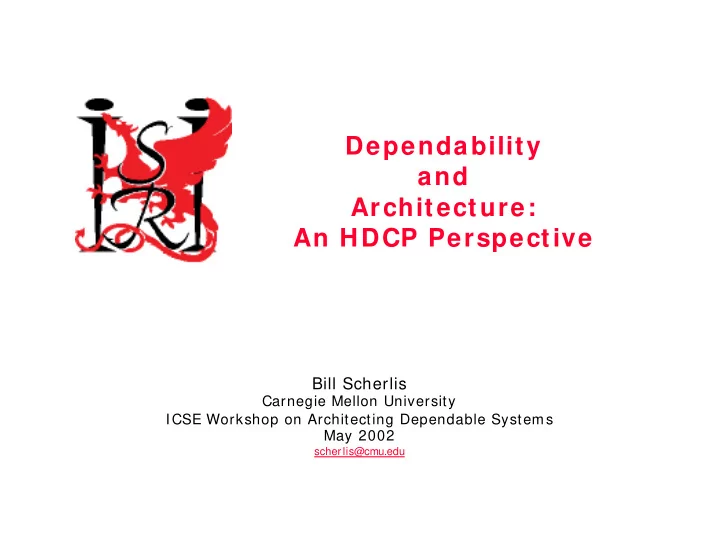

Dependability and Architecture: An HDCP Perspective Bill Scherlis Carnegie Mellon University ICSE Workshop on Architecting Dependable Systems May 2002 scher lis@cmu.edu
Dependability and Architecture • Dependability – Reliance that can justifiably be placed… – Fault tolerance – API robustness – Code safety – Safe concurrency – Usability – Availability – Self-healing – Etc. • Architecture – Structural constraint – That w hich changes m ost slow ly • Generally Accepted Linking Principle – Dynamic monitoring “Dependability designed in from the start” – Robust APIs and exception mgt – Self-healing – Framework compliance eval’n – Managed adaptation Carnegie Mellon
Observation • Sim ilar argum ents for from -the-start are m ade for m ultiple dependability attributes – Availability – Self-healing – Usability – Security Carnegie Mellon
Questions • W hat are the concrete research steps? – Beyond articulating precept on the basis of intuition and experience… – What does it mean to “design in” dependability ? • W hat are the dependability m easurables? – For the various attributes – How do we know if we are succeeding ? • W hat can be assured? – On the basis of architectural commitment? – What commitments can we make ? • How to reason about ( trust) the add’l structure? – Wrappers – Self-healing monitor/ detect/ log/ mitigate – FT availability architecture Carnegie Mellon
Exploring the Questions The HDCP program m atic approach • Testbeds – Experimentation at scale – Intervention – Measurement – Assurance • Scalable techniques – Frameworks – Composable attributes and analyses – Horizontal approaches Carnegie Mellon
Keep in Mind • Not m uch im pact of 3 0 -4 0 years of research in softw are dependability, broadly construed – Some notable exceptions • Some critical systems • Fully embedded practices – Programming language types • Certain analyses • Conventional architectural practices • Measurem ent? Carnegie Mellon
The HDCP Approach • Focus – Dependability at scale – Dependability and integration – Data, measurement, evaluation • Large-scale testbed projects – Identify actual challenges in NASA mission projects – Undertake experimental interventions • Measurement, improvement, assurance • Multiple interventions: risk m gt for stakeholders – NASA stakeholders directly involved – Distance collaboration support • Diverse team – CMU with USC, UMd, MIT, U Wash, U Wisc – Moffett campus Carnegie Mellon
The HDCP Approach • Research areas – Measurement and dependability (Boehm, Basili, Zelkowitz) – Analysis and assurance (Jackson, Koopman, Notkin, Scherlis) • Checking specifications • Concurrency and Java • Testing strategies • Robustness – Technological intervention (Garlan, Lee, Narasimhan, Reid, Shaw) • Self-healing architecture • Proof carrying code and mobility • Fault tolerance architecture • Secure dependable networking • Coalitions and anomaly detection – Usability and dependability (John, Bass) • Architecture and usability Carnegie Mellon
HDCP Status • Scale of effort – 5 years – 12 Lead investigators at 6 universities – Engineering team and collaboration infrastructure • Status – Testbed proposals submitted by NASA organizations – Testbed selection decision to be announced shortly • Related effort – NSF / NASA solicitation Carnegie Mellon
Dependability in the m ainstream ? • Practices for critical apps – Costly (orders of magnitude) – Significant sacrifices in capability and flexibility – Highly conservative (e.g., deterministic) architectures – Standards: rigor on surrogates (process, organization, etc .) • No trickle-dow n to m ainstream Sustainability – Engineered- in dependability – Evidenced through measurement and assurance – Supported by market and economic factors – Reachable from the present environment Carnegie Mellon
Dependability in the m ainstream ? Sustainability – Engineered- in dependability – Evidenced through measurement and assurance – Supported thru market and economic factors – Reachable from the present environment • Elem ents – Understand risk management challenges of users – Stakeholders: Users, Insurers, Auditors, Integrators, Vendors – Expertise: Technology, Economics, Markets, Law, Policy • Multi-university collaboration • Approach – Sustainable Computing Consortium (SCC) – Build on HDCP, SWIC, and other efforts – Collaborate with open source and other engineering communities • Goal – Engineering and market culture of dependability Carnegie Mellon
Prom ising directions ( exam ples) • Architecture- level intervention • Program analysis – Self-healing architecture – API client compliance evaluation (protocol, threading, – Transparent intervention etc) • Application-transparent FT – Buffer overflow detection, etc. (CORBA, etc.) • Dynamic monitoring/ logging – Annotation – Safe concurrency – Structural transformation • Wrapping • Advanced testing – Framework analysis – Robustness and APIs (Windows, – Mobile code architectures Linux) • Lightw eight form al m ethods • Correlative m easurem ent – Model checking of specs techniques – First-class encapsulation and types – CoQualMo, SecurityMM, ITsqc – “Narrow-band” assurance techniques • Usability-inform ed architecture design – Robustness for person-in-the-loop processes Carnegie Mellon
Prom ising problem s • Analysis and assurance for self-healing system s • Policy and assurance for self-organizing system s • Evaluation of dependability attributes for conventional architectures – The “standard” configuration for high availability data centers • Architecture-level specification • Form al linking of architecture specifications and low -level design / code Carnegie Mellon
Recommend
More recommend